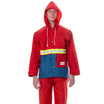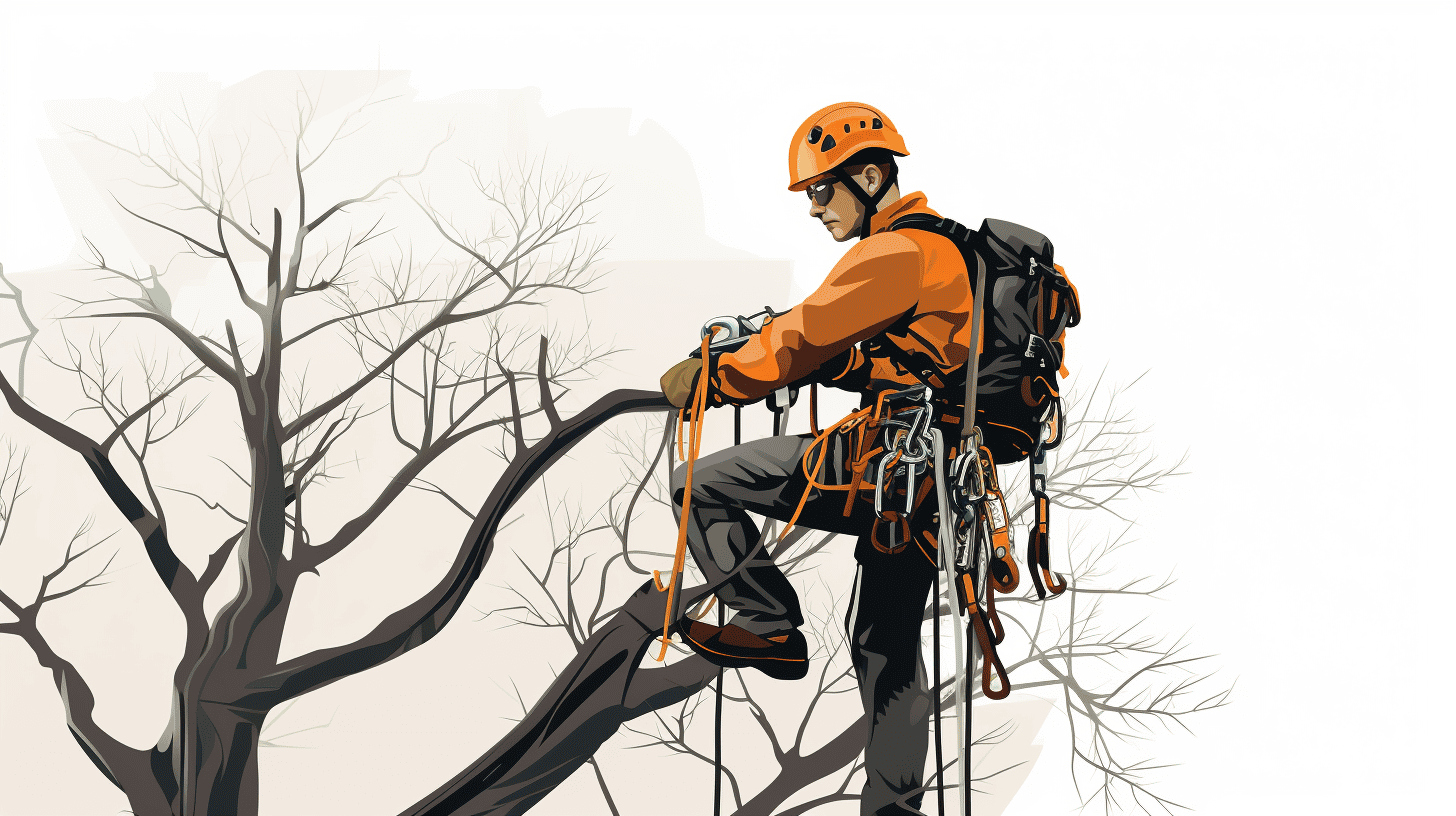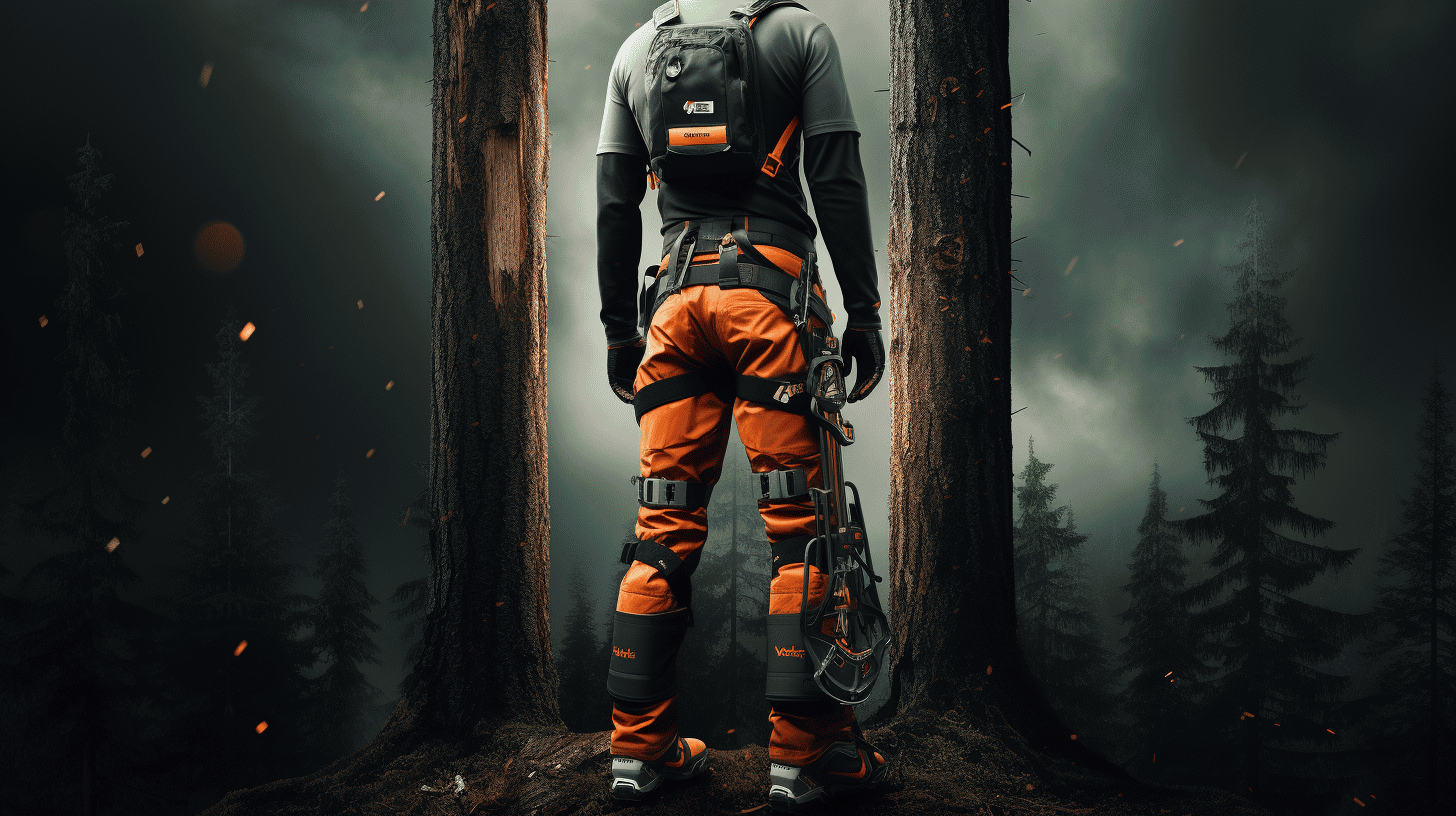Do you ever find yourself awestruck by the towering trees that fill our landscapes, standing like guardians of nature? Making sure they continue gracing us with their magnificent shades of green is the job of a skilled arborist, a veritable warrior of the woods. However, for every beautiful view we enjoy, it's crucial to remember the perils that come with the arboriculture profession.
The field of arboriculture – which encompasses the planting, maintaining, examining, and safe removal of trees – holds a great mix of immense reward and significant risk. When undertaken without suitable gear or adequate training, tree work can prove dangerous, even fatal. Working at dizzying heights, weather conditions to contend with, and handling of hazardous equipment are all intrinsic parts of the job.
This crucial introductory piece sets the tone for understanding the importance of safety gear within the arboriculture industry. It's not simply about safety glasses and a hard hat; a true arborist recognizes the value in being fully equipped, from lengthy chainsaw chaps to resilient fall protection. Read on, for a comprehensive understanding of arborist safety gear - your guide to ensuring personal safety while working.
Fatal and Nonfatal Occurrences in Arboriculture
The role of an Arborist or tree worker is an incredibly important one, yet it is often overlooked as being hazardous. Maintaining the health and vibrance of the world’s lush green canopies is no small task. Furthermore, it's essential to note just how much risk these green-thumb professionals are exposed to while doing so.
Tree Worker Fatalities Rate
Regrettably, the risks associated with arboriculture are no small potatoes. Astonishingly, a formidable 40% of fatal incidents in Arboriculture result from slips, falls, and mishaps during the climbing process. Furthermore, the harsh reality is that tree trimmers face a shockingly high fatality rate of 110 per 100,000 workers. This stark statistic sheds light on the dire need for enhanced safety measures within the industry.
Nonfatal Injuries Rate for Tree Trimmers
But the perils aren't contained to the merely fatal. Just as worrying is the prevalence of nonfatal injuries amongst tree workers. Let's consider the numbers: for every 10,000 tree trimmers, there are an estimated 239 nonfatal injuries. This high injury rate throws a spotlight on the daily risks these laborers face, again underscoring the urgent need for improved safety protocols to protect these essential workers.
Compared Incidents to Other Industries
To put these concerns into context, it's revealing to compare them with other industries. Startlingly, arborists face an astounding 15 times more fatalities and 3 times more injuries than those in most other fields of work. These grim statistics demonstrate the high-risk nature of arboriculture and the urgent need for effective safety regulation and enforcement.
The job of an arborist is clearly more perilous than many might imagine. Such brave souls, devoted to preserving and enhancing our natural arboreal wonders, unquestionably deserve the highest levels of protection and safety. The stark figures we've unmasked emphasize the significance and urgency of this need. With proper awareness and action, we can gradually make the world a safer place for these unsung eco-heroes.
Safety Gear and Its Importance
In a world where risks and hazards are a reality, especially in jobs involving physical labor and exposure to the elements, safety gear becomes more than just an optional accessory: it's a lifeline. It’s essential to understand that safety gear not only aids in protecting the wearer from unexpected circumstances but also serves to boost confidence, allowing individuals to perform their tasks more efficiently. This section delves deeper into different types of safety gear, highlighting their importance, and discussing how they could potentially save lives.
Personal first-aid kits
Among tree climbers, it is surprising to note that only 62% actually carry a personal first-aid kit. Such an oversight could prove fatal in the event of an unexpected incident. Whether a minor cut or a serious injury, a first-aid kit allows immediate treatment before professional medical aid arrives. Therefore, ensuring that one is always within reach isn't just a good idea—it's a life-saving practice.
Head protection
Working in fields such as construction or arboriculture comes with its own set of challenges, one of which is the risk of head injuries from falling debris. Consider, for example, a tree worker who is susceptible to the danger of falling branches. This fact explains why ANSI Z133-2017 safety requirements stipulate that head protection is mandatory for such professions. Donning a hard hat is not only compliant with mandated safety standards, but it could also mean the difference between a minor scratch and a trip to the emergency room.
Fall protection equipment
For professions involving heights, - like aerial-lift operators - the proper usage of fall protection equipment such as safety harnesses is crucial. One slip could lead to severe injuries, or worse, fatalities. Fall protection equipment, when used correctly, provides a safety net that catches the operator literally and metaphorically, cushioning the fall and preventing a tragic mishap.
In the realm of tree care, finding the Best Quality Products for Arborists could mean a world of difference when it comes to safety. It's imperative to choose equipment that meets safety standards, is durable, and suits the specific needs of the job at hand. Safety isn't just a policy—it's a lifestyle.
Hazards and Risks in Arboriculture
Arboriculture can be described as an art enriched with nature's splendor – the trimming and pruning of trees, witnessing them grow, and maintaining a balance in our environment. However, like any form of art, it's framed with challenges, forefront among them being safety hazards. Individuals in this line of work are often exposed to numerous risks that could lead to severe injuries or, in some cases, even fatalities.
Contact with Objects or Equipment
One of the most common types of hazards in arboriculture involves contact with objects or equipment, accounting for nearly 43% of all fatal incidents in this line of work. So, what exactly triggers these hazards? Well, falling branches, slips and trips over equipment, or even collision with heavy machinery are all part and parcel of the day-to-day operations in arboriculture.
Imagine cutting a hefty branch from atop a towering tree. On its way down, it could strike other branches, shed debris, or even cause the worker to lose balance. Striking objects in such manner can lead to severe injuries and occasionally, lethal accidents.
Chainsaw Injuries
Chainsaws – the signature tool of the arborist – are a powerful ally in taming nature's unruly branches and overgrowths. However, their raw power brings no small measure of danger that every arborist must bear in mind. Chainsaw-related injuries are a grim reality, claiming a staggering 80 arborist lives every year in North America, with an unsettling 23,000 chainsaw injuries annually.
Such alarming figures underscore the importance of proper training and use of protective equipment when handling chainsaws. These incisive tools demand respect and caution from their handlers – they are not to be casually toyed with. Additionally, appropriate work strategies should be employed to prevent kickbacks, and all safety protocols must be closely adhered to, limiting exposure to possible injuries.
Remember, every task in arboriculture, while serving an essential purpose, poses its own set of hazards. Mitigating these risks should not merely be viewed as a recommended practice – it’s a matter of life and death. The knowledge of these risks, coupled with consistent application of safety measures, would pave the way for a safer environment for everyone in the field of arboriculture.
Knowledge is power, especially when it comes to recognizing and preventing hazards and risks in arboriculture. Let's endeavor to wield this power responsibly and ensure a safer, greener world for all of us.
Importance of Regular Inspections
Regular inspections are a non-negotiable facet of maintaining a safe and efficient workplace. Whatever the industry, be it healthcare or construction, regular inspections of equipment foster a safe environment, reduce the risk of costly disruptions, and guarantee the longevity of your investments. By keeping potential safety hazards at bay, they not only protect assets but also uphold the well-being of operators in the workplace.
The Benefits
The advantages of routine inspections are manifold:
- Maintaining Equipment Functionality: Regular check-ups ensure that equipment is always working at prime condition, which in turn helps businesses to keep their operations running smoothly and efficiently.
- Extending Equipment Life: Routine inspections lead to early detection of wear and tear, aiding in timely repairs and maintenance of the equipment. This improved care results in an extended lifespan of your assets.
- Upkeeping Safety Standards: Regular inspections of equipment are crucial to identifying any potential safety hazards. By rooting out these problems at an early stage, the safety of the workplace is significantly enhanced.
- Avoiding Business Disruptions: When equipment fails unexpectedly, it can disrupt business operations, causing downtime and loss of profits. Regular inspections help prevent such unexpected malfunctions, thus eliminating costly disruptions.
Each of these points is a testament to the paramount importance of regular inspections, adding up to maintain the seamless functioning and safety of workplaces.
Implementing Regular Inspections
Implementing regular inspections doesn't have to be a herculean task, but it does require a clear plan and strategy. Begin by making an inventory of all the equipment in your workplace. Then, decide on the frequency of inspections based on the nature of the equipment and the risk it may present.
Next, establish clear guidelines for carrying out inspections, and make sure these are understood and followed by your staff. Train them about the importance of regular inspections, what to look for, and how to report potential safety hazards or malfunctions.
Finally, consider using modern technology to help manage these inspections. There are now a multitude of computerized maintenance management systems that can help you track equipment, schedule inspections and maintain a historical record of your inspections and any corrective actions taken.
Through diligence and careful planning, it's perfectly feasible to integrate regular inspections as a vital part of your operating routine - an investment that promises significant returns in the form of safety, efficiency, and equipment longevity. The respect for these principles will not only ensure the robustness of your business but also solidify your reputation as a responsible employer who values the safety and well-being of their staff.
Benefit of Being a Certified Arborist
Engaging with nature and contributing to its health is undoubtedly a rewarding career. For professionals who work with trees, being a certified arborist provides commendable standing in the field. This certification, governed by the International Society of Arboriculture (ISA), is evidence of your expertise and a testament to your commitment to upholding the highest standards of tree care.
Certified arborists bring a wealth of benefits not just to themselves but also to the environment and communities they serve. Let’s explore why being an ISA-certified arborist is a pivotal career milestone and how it impacts the larger ecosystem.
Unmatched Expertise & Credibility
Earning an ISA certification is no small feat. It involves rigorous study, extensive fieldwork, and passing a stringent examination. Thus, certified arborists are expected to have a deep understanding of the fundamentals of arboriculture, including tree biology, diagnosis and treatment of tree diseases, soil management, and safe work practices. This knowledge is not just theoretical - certified arborists have demonstrated their ability to apply these principles practically.
Being an ISA-certified arborist also fosters a sense of credibility. Certification signals that the arborist is committed to a standard of excellence and keeps updated with the latest advancements in tree care. As a result, clients and employers are more likely to trust and prefer arborists with this certification.
Staying Ahead with the Latest Techniques in Arboriculture
The tree care industry is continually evolving, with new practices, tools, and techniques being developed all the time. Certified arborists are more likely to be up-to-date on the latest techniques in arboriculture. Thanks to the mandatory continuing education unit (CEU) requirements, they are required to learn about new practices and innovations in the field.
Enhanced Professional Growth
Holding an ISA certification can spur professional growth. As a recognized mark of achievement, it can open doors to better job opportunities, higher compensation, and career advancement. Furthermore, the certification arms arborists with the confidence to tackle complex tasks, carve a niche, and even start their own businesses.
Positive Community Impact
Certified arborists don't just work on trees; they contribute to enhancing the green spaces in our communities. Their expertise can significantly impact urban forestry, helping nurture healthier, more robust trees that provide environmental benefits like improved air quality and stormwater management.
Being a certified arborist is more than just a mark of distinction; it equips professionals with the knowledge and skills necessary to improve tree health, foster a sustainable environment, and drive community well-being. So the next time you see an ISA-certified arborist at work, take a moment to acknowledge their significant contribution to the welfare of our urban foliage.
Conclusion
Arboreal work does not have to be a risky occupation. With the right training, regular equipment inspections, and high-quality personal protective gear, the number of injuries, or even fatalities, can be significantly reduced. The importance of safety cannot be stated enough, which is why companies like Rain Gear Pro dedicate their efforts to creating reliable and durable safety clothing. Known for their superior chainsaw safety pants, the company is paving the way for safer work environments in arboriculture, melding protection and comfort effortlessly.
Remember, safety is not just a word; it's a commitment. A commitment to oneself and fellow workers. So, let's ensure personal safety while working and contribute to a safer workspace with the right gear.
Stay safe, stay protected.
Frequently Asked Questions
-
What are the essential safety gear for arborists?
The essential safety gear for arborists includes a hard hat, eye and face protection, hearing protection, chainsaw chaps or pants, sturdy boots, gloves, and a high-visibility vest or shirt.
-
Why is wearing a hard hat important for arborists?
Wearing a hard hat is crucial for arborists as it protects the head from falling branches, debris, and other overhead hazards. It reduces the risk of head injuries and provides added safety while working at heights.
-
What type of eye and face protection should arborists wear?
Arborists should wear safety glasses or goggles with side shields to protect their eyes from flying wood chips, dust, and other debris. Additionally, a visor or face shield can be worn for added protection when operating chainsaws or using high-powered equipment.
-
How are chainsaw chaps or pants beneficial for arborists?
Chainsaw chaps or pants are designed with cut-resistant material, such as Kevlar, which helps protect arborists' legs from accidental cuts or injuries while working with chainsaws. They provide an extra layer of safety and are a must-have for any arborist.
-
Why is wearing a high-visibility vest important for arborists?
Wearing a high-visibility vest or shirt improves the visibility of arborists, especially when working near roadways or in areas with heavy machinery. It helps ensure that they are easily seen by other workers, drivers, or pedestrians, reducing the risk of accidents.























Leave a comment
This site is protected by hCaptcha and the hCaptcha Privacy Policy and Terms of Service apply.